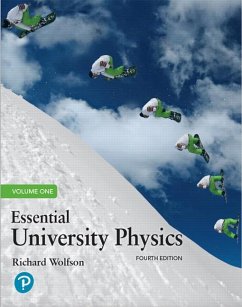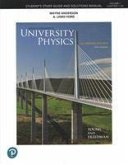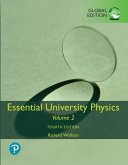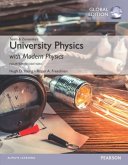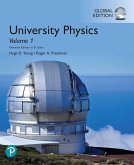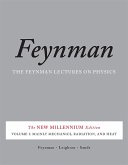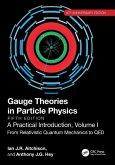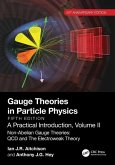Richard Wolfson
Essential University Physics, Volume 1
Richard Wolfson
Essential University Physics, Volume 1
- Broschiertes Buch
- Merkliste
- Auf die Merkliste
- Bewerten Bewerten
- Teilen
- Produkt teilen
- Produkterinnerung
- Produkterinnerung
For two- and three-semester university physics courses. 0134988558 / 9780134988559: Volume 1 contains Chapters 1—19 Focus on the fundamentals and help students see connections between problem types Richard Wolfson’s Essential University Physics is a concise and progressive calculus-based physics textbook that offers clear writing, great problems, and relevant real-life applications in an affordable and streamlined text. The book teaches sound problem-solving strategies and emphasizes conceptual understanding, using features such as annotated figures and step-by-step problem-solving…mehr
Andere Kunden interessierten sich auch für
![Student Study Guide and Solutions Manual for University Physics, Volume 1 (Chapters 1-20) Student Study Guide and Solutions Manual for University Physics, Volume 1 (Chapters 1-20)]() Hugh YoungStudent Study Guide and Solutions Manual for University Physics, Volume 1 (Chapters 1-20)88,99 €
Hugh YoungStudent Study Guide and Solutions Manual for University Physics, Volume 1 (Chapters 1-20)88,99 €![Essential University Physics, Volume 2, Global Edition Essential University Physics, Volume 2, Global Edition]() Richard WolfsonEssential University Physics, Volume 2, Global Edition80,99 €
Richard WolfsonEssential University Physics, Volume 2, Global Edition80,99 €![University Physics with Modern Physics, Volume 2 (Chs. 21-37), Global Edition University Physics with Modern Physics, Volume 2 (Chs. 21-37), Global Edition]() Hugh YoungUniversity Physics with Modern Physics, Volume 2 (Chs. 21-37), Global Edition13,99 €
Hugh YoungUniversity Physics with Modern Physics, Volume 2 (Chs. 21-37), Global Edition13,99 €![University Physics, Volume 1 (Chapters 1-20), Global Edition University Physics, Volume 1 (Chapters 1-20), Global Edition]() Hugh YoungUniversity Physics, Volume 1 (Chapters 1-20), Global Edition102,99 €
Hugh YoungUniversity Physics, Volume 1 (Chapters 1-20), Global Edition102,99 €![The Feynman Lectures on Physics, Volume I The Feynman Lectures on Physics, Volume I]() Matthew SandsThe Feynman Lectures on Physics, Volume I59,99 €
Matthew SandsThe Feynman Lectures on Physics, Volume I59,99 €![Gauge Theories in Particle Physics, 40th Anniversary Edition: A Practical Introduction, Volume 1 Gauge Theories in Particle Physics, 40th Anniversary Edition: A Practical Introduction, Volume 1]() Ian J R Aitchison (Univ. of Oxford Prof. Em.)Gauge Theories in Particle Physics, 40th Anniversary Edition: A Practical Introduction, Volume 174,99 €
Ian J R Aitchison (Univ. of Oxford Prof. Em.)Gauge Theories in Particle Physics, 40th Anniversary Edition: A Practical Introduction, Volume 174,99 €![Gauge Theories in Particle Physics, 40th Anniversary Edition: A Practical Introduction, Volume 2 Gauge Theories in Particle Physics, 40th Anniversary Edition: A Practical Introduction, Volume 2]() Ian J R Aitchison (Univ. of Oxford Prof. Em.)Gauge Theories in Particle Physics, 40th Anniversary Edition: A Practical Introduction, Volume 274,99 €
Ian J R Aitchison (Univ. of Oxford Prof. Em.)Gauge Theories in Particle Physics, 40th Anniversary Edition: A Practical Introduction, Volume 274,99 €-
-
-
For two- and three-semester university physics courses. 0134988558 / 9780134988559: Volume 1 contains Chapters 1—19 Focus on the fundamentals and help students see connections between problem types Richard Wolfson’s Essential University Physics is a concise and progressive calculus-based physics textbook that offers clear writing, great problems, and relevant real-life applications in an affordable and streamlined text. The book teaches sound problem-solving strategies and emphasizes conceptual understanding, using features such as annotated figures and step-by-step problem-solving strategies. Realizing students have changed a great deal over time while the fundamentals of physics have changed very little, Wolfson makes physics relevant and alive for students by sharing the latest physics applications in a succinct and captivating style. The 4th Edition incorporates research from instructors, reviewers, and thousands of students to expand the book’s problem sets and consistent problem-solving strategy. A new problem type guides students to see patterns, make connections between problems that can be solved using similar steps, and apply those steps when working problems on homework and exams. New digital tools and the interactive Pearson eText increase student interactivity to help them develop confidence in solving problems, deepen their conceptual understanding, and strengthen quantitative-reasoning skills. Essential University Physics is offered as two paperback volumes available together or for sale individually. Also available with Mastering Physics Mastering™ is the teaching and learning platform that empowers you to reach every student. By combining trusted author content with digital tools developed to engage students and emulate the office-hour experience, Mastering personalizes learning and improves results for each student. Now providing a fully integrated experience, the eText is linked to every problem within Mastering for seamless integration between homework problems, practice problems, textbook, worked examples, and more. Learn more about Mastering Physics.
Hinweis: Dieser Artikel kann nur an eine deutsche Lieferadresse ausgeliefert werden.
Hinweis: Dieser Artikel kann nur an eine deutsche Lieferadresse ausgeliefert werden.
Produktdetails
- Produktdetails
- Verlag: Pearson Education (US)
- 4 ed
- Seitenzahl: 432
- Erscheinungstermin: 4. Januar 2019
- Englisch
- Abmessung: 216mm x 277mm x 16mm
- Gewicht: 908g
- ISBN-13: 9780134988559
- ISBN-10: 0134988558
- Artikelnr.: 57175514
- Verlag: Pearson Education (US)
- 4 ed
- Seitenzahl: 432
- Erscheinungstermin: 4. Januar 2019
- Englisch
- Abmessung: 216mm x 277mm x 16mm
- Gewicht: 908g
- ISBN-13: 9780134988559
- ISBN-10: 0134988558
- Artikelnr.: 57175514
About our author R ichard Wolfson is the Benjamin F. Wissler Professor of Physics at Middlebury College, where he has taught since 1976. He did undergraduate work at MIT and Swarthmore College, and he holds an M.S. from the University of Michigan and Ph.D. from Dartmouth. His ongoing research on the Sun’s corona and climate change has taken him to sabbaticals at the National Center for Atmospheric Research in Boulder, Colorado; St. Andrews University in Scotland; and Stanford University. Rich is a committed and passionate teacher. This is reflected in his many publications for students and the general public, including the video series Einstein’s Relativity and the Quantum Revolution: Modern Physics for Nonscientists (The Teaching Company, 1999), Physics in Your Life (The Teaching Company, 2004), Physics and Our Universe: How It All Works (The Teaching Company, 2011), and Understanding Modern Electronics(The Teaching Company, 2014); books Nuclear Choices: A Citizen’s Guide to Nuclear Technology (MIT Press, 1993), Simply Einstein: Relativity Demystified (W. W. Norton, 2003), and Energy, Environment, and Climate(W. W. Norton, 3rd edition 2018); and articles for Scientific American and the World Book Encyclopedia. Outside of his research and teaching, Rich enjoys hiking, canoeing, gardening, cooking, and watercolor painting.
Essential University Physics, 4th Edition is available in 3 versions:
* Full Version, All Chapters: Chs 1-39
* Volume 1: Chs 1-19
* Volume 2: Chs 20-39
1. Doing Physics
* 1.1 Realms of Physics
* 1.2 Measurements and Units
* 1.3 Working with Numbers
* 1.4 Strategies for Learning Physics
PART ONE: MECHANICS
1. Motion in a Straight Line
* 2.1 Average Motion
* 2.2 Instantaneous Velocity
* 2.3 Acceleration
* 2.4 Constant Acceleration
* 2.5 The Acceleration of Gravity
* 2.6 When Acceleration Isn't Constant
2. Motion in Two and Three Dimensions
* 3.1 Vectors
* 3.2 Velocity and Acceleration Vectors
* 3.3 Relative Motion
* 3.4 Constant Acceleration
* 3.5 Projectile Motion
* 3.6 Uniform Circular Motion
3. Force and Motion
* 4.1 The Wrong Question
* 4.2 Newton's First and Second Laws
* 4.3 Forces
* 4.4 The Force of Gravity
* 4.5 Using Newton's Second Law
* 4.6 Newton's Third Law
4. Using Newton's Laws
* 5.1 Using Newton's Second Law
* 5.2 Multiple Objects
* 5.3 Circular Motion
* 5.4 Friction
* 5.5 Drag Forces
5. Energy, Work, and Power
* 6.1 Energy
* 6.2 Work
* 6.3 Forces That Vary
* 6.4 Kinetic Energy
* 6.5 Power
6. Conservation of Energy
* 7.1 Conservative and Nonconservative Forces
* 7.2 Potential Energy
* 7.3 Conservation of Mechanical Energy
* 7.4 Nonconservative Forces
* 7.5 Conservation of Energy
* 7.6 Potential-Energy Curves
7. Gravity
* 8.1 Toward a Law of Gravity
* 8.2 Universal Gravitation
* 8.3 Orbital Motion
* 8.4 Gravitational Energy
* 8.5 The Gravitational Field
8. Systems of Particles
* 9.1 Center of Mass
* 9.2 Momentum
* 9.3 Kinetic Energy of a System
* 9.4 Collisions
* 9.5 Totally Inelastic Collisions
* 9.6 Elastic Collisions
9. Rotational Motion
* 10.1 Angular Velocity and Acceleration
* 10.2 Torque
* 10.3 Rotational Inertia and the Analog of Newton's Law
* 10.4 Rotational Energy
* 10.5 Rolling Motion
10. Rotational Vectors and Angular Momentum
* 11.1 Angular Velocity and Acceleration Vectors
* 11.2 Torque and the Vector Cross Product
* 11.3 Angular Momentum
* 11.4 Conservation of Angular Momentum
* 11.5 Gyroscopes and Precession
11. Static Equilibrium
* 12.1 Conditions for Equilibrium
* 12.2 Center of Gravity
* 12.3 Examples of Static Equilibrium
* 12.4 Stability
PART TWO: OSCILLATIONS, WAVES, AND FLUIDS
12. Oscillatory Motion
* 13.1 Describing Oscillatory Motion
* 13.2 Simple Harmonic Motion
* 13.3 Applications of Simple Harmonic Motion
* 13.4 Circular Motion and Harmonic Motion
* 13.5 Energy in Simple Harmonic Motion
* 13.6 Damped Harmonic Motion
* 13.7 Driven Oscillations and Resonance
13. 14. Wave Motion
* 14.1 Waves and Their Properties
* 14.2 Wave Math
* 14.3 Waves on a String
* 14.4 Wave Energy
* 14.5 Sound Waves
* 14.6 Interference
* 14.7 Reflection and Refraction
* 14.8 Standing Waves
* 14.9 The Doppler Effect and Shock Waves
14. Fluid Motion
* 15.1 Density and Pressure
* 15.2 Hydrostatic Equilibrium
* 15.3 Archimedes' Principle and Buoyancy
* 15.4 Fluid Dynamics
* 15.5 Applications of Fluid Dynamics
* 15.6 Viscosity and Turbulence
PART THREE: THERMODYNAMICS
15. Temperature and Heat
* 16.1 Heat, Temperature, and Thermodynamic Equilibrium
* 16.2 Heat Capacity and Specific Heat
* 16.3 Heat Transfer
* 16.4 Thermal-Energy Balance
16. The Thermal Behavior of Matter
* 17.1 Gases
* 17.2 Phase Changes
* 17.3 Thermal Expansion
17. Heat, Work, and the First Law of Thermodynamics
* 18.1 The First Law of Thermodynamics
* 18.2 Thermodynamic Processes
* 18.3 Specific Heats of an Ideal Gas
18. The Second Law of Thermodynamics
* 19.1 Reversibility and Irreversibility
* 19.2 The Second Law of Thermodynamics
* 19.3 Applications of the Second Law
* 19.4 Entropy and Energy Quality
PART FOUR: ELECTROMAGNETISM
19. Electric Charge, Force, and Field
* 20.1 Electric Charge
* 20.2 Coulomb's Law
* 20.3 The Electric Field
* 20.4 Fields of Charge Distributions
* 20.5 Matter in Electric Fields
20. Gauss's Law
* 21.1 Electric Field Lines
* 21.2 Electric Field and Electric Flux
* 21.3 Gauss's Law
* 21.4 Using Gauss's Law
* 21.5 Fields of Arbitrary Charge Distributions
* 21.6 Gauss's Law and Conductors
21. Electric Potential
* 22.1 Electric Potential Difference
* 22.2 Calculating Potential Difference
* 22.3 Potential Difference and the Electric Field
* 22.4 Charged Conductors
22. Electrostatic Energy and Capacitors
* 23.1 Electrostatic Energy
* 23.2 Capacitors
* 23.3 Using Capacitors
* 23.4 Energy in the Electric Field
23. Electric Current
* 24.1 Electric Current
* 24.2 Conduction Mechanisms
* 24.3 Resistance and Ohm's Law
* 24.4 Electric Power
* 24.5 Electrical Safety
24. Electric Circuits
* 25.1 Circuits, Symbols, and Electromotive Force
* 25.2 Series and Parallel Resistors
* 25.3 Kirchhoff's Laws and Multiloop Circuits
* 25.4 Electrical Measurements
* 25.5 Capacitors in Circuits
25. Magnetism: Force and Field
* 26.1 What Is Magnetism?
* 26.2 Magnetic Force and Field
* 26.3 Charged Particles in Magnetic Fields
* 26.4 The Magnetic Force on a Current
* 26.5 Origin of the Magnetic Field
* 26.6 Magnetic Dipoles
* 26.7 Magnetic Matter
* 26.8 Ampère's Law
26. Electromagnetic Induction
* 27.1 Induced Currents
* 27.2 Faraday's Law
* 27.3 Induction and Energy
* 27.4 Inductance
* 27.5 Magnetic Energy
* 27.6 Induced Electric Fields
27. Alternating-Current Circuits
* 28.1 Alternating Current
* 28.2 Circuit Elements in AC Circuits
* 28.3 LC Circuits
* 28.4 Driven RLC Circuits and Resonance
* 28.5 Power in AC Circuits
* 28.6 Transformers and Power Supplies
28. Maxwell's Equations and Electromagnetic Waves
* 29.1 The Four Laws of Electromagnetism
* 29.2 Ambiguity in Ampère's Law
* 29.3 Maxwell's Equations
* 29.4 Electromagnetic Waves
* 29.5 Properties of Electromagnetic Waves
* 29.6 The Electromagnetic Spectrum
* 29.7 Producing Electromagnetic Waves
* 29.8 Energy and Momentum in Electromagnetic Waves
PART FIVE: OPTICS
29. Reflection and Refraction
* 30.1 Reflection
* 30.2 Refraction
* 30.3 Total Internal Reflection
* 30.4 Dispersion
30. Images and Optical Instruments
* 31.1 Images with Mirrors
* 31.2 Images with Lenses
* 31.3 Refraction in Lenses: The Details
* 31.4 Optical Instruments
31. Interference and Diffraction
* 32.1 Coherence and Interference
* 32.2 Double-Slit Interference
* 32.3 Multiple-Slit Interference and Diffraction Gratings
* 32.4 Interferometry
* 32.5 Huygens' Principle and Diffraction
* 32.6 The Diffraction Limit
PART SIX: MODERN PHYSICS
32. Relativity
* 33.1 Speed c Relative to What?
* 33.2 Matter, Motion, and the Ether
* 33.3 Special Relativity
* 33.4 Space and Time in Relativity
* 33.5 Simultaneity Is Relative
* 33.6 The Lorentz Transformations
* 33.7 Energy and Momentum in Relativity
* 33.8 Electromagnetism and Relativity
* 33.9 General Relativity
33. Particles and Waves
* 34.1 Toward Quantum Theory
* 34.2 Blackbody Radiation
* 34.3 Photons
* 34.4 Atomic Spectra and the Bohr Atom
* 34.5 Matter Waves
* 34.6 The Uncertainty Principle
* 34.7 Complementarity
34. Quantum Mechanics
* 35.1 Particles, Waves, and Probability
* 35.2 The Schrödinger Equation
* 35.3 Particles and Potentials
* 35.4 Quantum Mechanics in Three Dimensions
* 35.5 Relativistic Quantum Mechanics
35. Atomic Physics
* 36.1 The Hydrogen Atom
* 36.2 Electron Spin
* 36.3 The Exclusion Principle
* 36.4 Multielectron Atoms and the Periodic Table
* 36.5 Transitions and Atomic Spectra
36. Molecules and Solids
* 37.1 Molecular Bonding
* 37.2 Molecular Energy Levels
* 37.3 Solids
* 37.4 Superconductivity
37. Nuclear Physics
* 38.1 Elements, Isotopes, and Nuclear Structure
* 38.2 Radioactivity
* 38.3 Binding Energy and Nucleosynthesis
* 38.4 Nuclear Fission
* 38.5 Nuclear Fusion
38. From Quarks to the Cosmos
* 39.1 Particles and Forces
* 39.2 Particles and More Particles
* 39.3 Quarks and the Standard Model
* 39.4 Unification
* 39.5 The Evolving Universe
APPENDICES
* A. Mathematics
* B. The International System of Units (SI)
* C. Conversion Factors
* D. The Elements
* E. Astrophysical Data
* Answers to Odd-Numbered Problems
* Full Version, All Chapters: Chs 1-39
* Volume 1: Chs 1-19
* Volume 2: Chs 20-39
1. Doing Physics
* 1.1 Realms of Physics
* 1.2 Measurements and Units
* 1.3 Working with Numbers
* 1.4 Strategies for Learning Physics
PART ONE: MECHANICS
1. Motion in a Straight Line
* 2.1 Average Motion
* 2.2 Instantaneous Velocity
* 2.3 Acceleration
* 2.4 Constant Acceleration
* 2.5 The Acceleration of Gravity
* 2.6 When Acceleration Isn't Constant
2. Motion in Two and Three Dimensions
* 3.1 Vectors
* 3.2 Velocity and Acceleration Vectors
* 3.3 Relative Motion
* 3.4 Constant Acceleration
* 3.5 Projectile Motion
* 3.6 Uniform Circular Motion
3. Force and Motion
* 4.1 The Wrong Question
* 4.2 Newton's First and Second Laws
* 4.3 Forces
* 4.4 The Force of Gravity
* 4.5 Using Newton's Second Law
* 4.6 Newton's Third Law
4. Using Newton's Laws
* 5.1 Using Newton's Second Law
* 5.2 Multiple Objects
* 5.3 Circular Motion
* 5.4 Friction
* 5.5 Drag Forces
5. Energy, Work, and Power
* 6.1 Energy
* 6.2 Work
* 6.3 Forces That Vary
* 6.4 Kinetic Energy
* 6.5 Power
6. Conservation of Energy
* 7.1 Conservative and Nonconservative Forces
* 7.2 Potential Energy
* 7.3 Conservation of Mechanical Energy
* 7.4 Nonconservative Forces
* 7.5 Conservation of Energy
* 7.6 Potential-Energy Curves
7. Gravity
* 8.1 Toward a Law of Gravity
* 8.2 Universal Gravitation
* 8.3 Orbital Motion
* 8.4 Gravitational Energy
* 8.5 The Gravitational Field
8. Systems of Particles
* 9.1 Center of Mass
* 9.2 Momentum
* 9.3 Kinetic Energy of a System
* 9.4 Collisions
* 9.5 Totally Inelastic Collisions
* 9.6 Elastic Collisions
9. Rotational Motion
* 10.1 Angular Velocity and Acceleration
* 10.2 Torque
* 10.3 Rotational Inertia and the Analog of Newton's Law
* 10.4 Rotational Energy
* 10.5 Rolling Motion
10. Rotational Vectors and Angular Momentum
* 11.1 Angular Velocity and Acceleration Vectors
* 11.2 Torque and the Vector Cross Product
* 11.3 Angular Momentum
* 11.4 Conservation of Angular Momentum
* 11.5 Gyroscopes and Precession
11. Static Equilibrium
* 12.1 Conditions for Equilibrium
* 12.2 Center of Gravity
* 12.3 Examples of Static Equilibrium
* 12.4 Stability
PART TWO: OSCILLATIONS, WAVES, AND FLUIDS
12. Oscillatory Motion
* 13.1 Describing Oscillatory Motion
* 13.2 Simple Harmonic Motion
* 13.3 Applications of Simple Harmonic Motion
* 13.4 Circular Motion and Harmonic Motion
* 13.5 Energy in Simple Harmonic Motion
* 13.6 Damped Harmonic Motion
* 13.7 Driven Oscillations and Resonance
13. 14. Wave Motion
* 14.1 Waves and Their Properties
* 14.2 Wave Math
* 14.3 Waves on a String
* 14.4 Wave Energy
* 14.5 Sound Waves
* 14.6 Interference
* 14.7 Reflection and Refraction
* 14.8 Standing Waves
* 14.9 The Doppler Effect and Shock Waves
14. Fluid Motion
* 15.1 Density and Pressure
* 15.2 Hydrostatic Equilibrium
* 15.3 Archimedes' Principle and Buoyancy
* 15.4 Fluid Dynamics
* 15.5 Applications of Fluid Dynamics
* 15.6 Viscosity and Turbulence
PART THREE: THERMODYNAMICS
15. Temperature and Heat
* 16.1 Heat, Temperature, and Thermodynamic Equilibrium
* 16.2 Heat Capacity and Specific Heat
* 16.3 Heat Transfer
* 16.4 Thermal-Energy Balance
16. The Thermal Behavior of Matter
* 17.1 Gases
* 17.2 Phase Changes
* 17.3 Thermal Expansion
17. Heat, Work, and the First Law of Thermodynamics
* 18.1 The First Law of Thermodynamics
* 18.2 Thermodynamic Processes
* 18.3 Specific Heats of an Ideal Gas
18. The Second Law of Thermodynamics
* 19.1 Reversibility and Irreversibility
* 19.2 The Second Law of Thermodynamics
* 19.3 Applications of the Second Law
* 19.4 Entropy and Energy Quality
PART FOUR: ELECTROMAGNETISM
19. Electric Charge, Force, and Field
* 20.1 Electric Charge
* 20.2 Coulomb's Law
* 20.3 The Electric Field
* 20.4 Fields of Charge Distributions
* 20.5 Matter in Electric Fields
20. Gauss's Law
* 21.1 Electric Field Lines
* 21.2 Electric Field and Electric Flux
* 21.3 Gauss's Law
* 21.4 Using Gauss's Law
* 21.5 Fields of Arbitrary Charge Distributions
* 21.6 Gauss's Law and Conductors
21. Electric Potential
* 22.1 Electric Potential Difference
* 22.2 Calculating Potential Difference
* 22.3 Potential Difference and the Electric Field
* 22.4 Charged Conductors
22. Electrostatic Energy and Capacitors
* 23.1 Electrostatic Energy
* 23.2 Capacitors
* 23.3 Using Capacitors
* 23.4 Energy in the Electric Field
23. Electric Current
* 24.1 Electric Current
* 24.2 Conduction Mechanisms
* 24.3 Resistance and Ohm's Law
* 24.4 Electric Power
* 24.5 Electrical Safety
24. Electric Circuits
* 25.1 Circuits, Symbols, and Electromotive Force
* 25.2 Series and Parallel Resistors
* 25.3 Kirchhoff's Laws and Multiloop Circuits
* 25.4 Electrical Measurements
* 25.5 Capacitors in Circuits
25. Magnetism: Force and Field
* 26.1 What Is Magnetism?
* 26.2 Magnetic Force and Field
* 26.3 Charged Particles in Magnetic Fields
* 26.4 The Magnetic Force on a Current
* 26.5 Origin of the Magnetic Field
* 26.6 Magnetic Dipoles
* 26.7 Magnetic Matter
* 26.8 Ampère's Law
26. Electromagnetic Induction
* 27.1 Induced Currents
* 27.2 Faraday's Law
* 27.3 Induction and Energy
* 27.4 Inductance
* 27.5 Magnetic Energy
* 27.6 Induced Electric Fields
27. Alternating-Current Circuits
* 28.1 Alternating Current
* 28.2 Circuit Elements in AC Circuits
* 28.3 LC Circuits
* 28.4 Driven RLC Circuits and Resonance
* 28.5 Power in AC Circuits
* 28.6 Transformers and Power Supplies
28. Maxwell's Equations and Electromagnetic Waves
* 29.1 The Four Laws of Electromagnetism
* 29.2 Ambiguity in Ampère's Law
* 29.3 Maxwell's Equations
* 29.4 Electromagnetic Waves
* 29.5 Properties of Electromagnetic Waves
* 29.6 The Electromagnetic Spectrum
* 29.7 Producing Electromagnetic Waves
* 29.8 Energy and Momentum in Electromagnetic Waves
PART FIVE: OPTICS
29. Reflection and Refraction
* 30.1 Reflection
* 30.2 Refraction
* 30.3 Total Internal Reflection
* 30.4 Dispersion
30. Images and Optical Instruments
* 31.1 Images with Mirrors
* 31.2 Images with Lenses
* 31.3 Refraction in Lenses: The Details
* 31.4 Optical Instruments
31. Interference and Diffraction
* 32.1 Coherence and Interference
* 32.2 Double-Slit Interference
* 32.3 Multiple-Slit Interference and Diffraction Gratings
* 32.4 Interferometry
* 32.5 Huygens' Principle and Diffraction
* 32.6 The Diffraction Limit
PART SIX: MODERN PHYSICS
32. Relativity
* 33.1 Speed c Relative to What?
* 33.2 Matter, Motion, and the Ether
* 33.3 Special Relativity
* 33.4 Space and Time in Relativity
* 33.5 Simultaneity Is Relative
* 33.6 The Lorentz Transformations
* 33.7 Energy and Momentum in Relativity
* 33.8 Electromagnetism and Relativity
* 33.9 General Relativity
33. Particles and Waves
* 34.1 Toward Quantum Theory
* 34.2 Blackbody Radiation
* 34.3 Photons
* 34.4 Atomic Spectra and the Bohr Atom
* 34.5 Matter Waves
* 34.6 The Uncertainty Principle
* 34.7 Complementarity
34. Quantum Mechanics
* 35.1 Particles, Waves, and Probability
* 35.2 The Schrödinger Equation
* 35.3 Particles and Potentials
* 35.4 Quantum Mechanics in Three Dimensions
* 35.5 Relativistic Quantum Mechanics
35. Atomic Physics
* 36.1 The Hydrogen Atom
* 36.2 Electron Spin
* 36.3 The Exclusion Principle
* 36.4 Multielectron Atoms and the Periodic Table
* 36.5 Transitions and Atomic Spectra
36. Molecules and Solids
* 37.1 Molecular Bonding
* 37.2 Molecular Energy Levels
* 37.3 Solids
* 37.4 Superconductivity
37. Nuclear Physics
* 38.1 Elements, Isotopes, and Nuclear Structure
* 38.2 Radioactivity
* 38.3 Binding Energy and Nucleosynthesis
* 38.4 Nuclear Fission
* 38.5 Nuclear Fusion
38. From Quarks to the Cosmos
* 39.1 Particles and Forces
* 39.2 Particles and More Particles
* 39.3 Quarks and the Standard Model
* 39.4 Unification
* 39.5 The Evolving Universe
APPENDICES
* A. Mathematics
* B. The International System of Units (SI)
* C. Conversion Factors
* D. The Elements
* E. Astrophysical Data
* Answers to Odd-Numbered Problems
Essential University Physics, 4th Edition is available in 3 versions:
* Full Version, All Chapters: Chs 1-39
* Volume 1: Chs 1-19
* Volume 2: Chs 20-39
1. Doing Physics
* 1.1 Realms of Physics
* 1.2 Measurements and Units
* 1.3 Working with Numbers
* 1.4 Strategies for Learning Physics
PART ONE: MECHANICS
1. Motion in a Straight Line
* 2.1 Average Motion
* 2.2 Instantaneous Velocity
* 2.3 Acceleration
* 2.4 Constant Acceleration
* 2.5 The Acceleration of Gravity
* 2.6 When Acceleration Isn't Constant
2. Motion in Two and Three Dimensions
* 3.1 Vectors
* 3.2 Velocity and Acceleration Vectors
* 3.3 Relative Motion
* 3.4 Constant Acceleration
* 3.5 Projectile Motion
* 3.6 Uniform Circular Motion
3. Force and Motion
* 4.1 The Wrong Question
* 4.2 Newton's First and Second Laws
* 4.3 Forces
* 4.4 The Force of Gravity
* 4.5 Using Newton's Second Law
* 4.6 Newton's Third Law
4. Using Newton's Laws
* 5.1 Using Newton's Second Law
* 5.2 Multiple Objects
* 5.3 Circular Motion
* 5.4 Friction
* 5.5 Drag Forces
5. Energy, Work, and Power
* 6.1 Energy
* 6.2 Work
* 6.3 Forces That Vary
* 6.4 Kinetic Energy
* 6.5 Power
6. Conservation of Energy
* 7.1 Conservative and Nonconservative Forces
* 7.2 Potential Energy
* 7.3 Conservation of Mechanical Energy
* 7.4 Nonconservative Forces
* 7.5 Conservation of Energy
* 7.6 Potential-Energy Curves
7. Gravity
* 8.1 Toward a Law of Gravity
* 8.2 Universal Gravitation
* 8.3 Orbital Motion
* 8.4 Gravitational Energy
* 8.5 The Gravitational Field
8. Systems of Particles
* 9.1 Center of Mass
* 9.2 Momentum
* 9.3 Kinetic Energy of a System
* 9.4 Collisions
* 9.5 Totally Inelastic Collisions
* 9.6 Elastic Collisions
9. Rotational Motion
* 10.1 Angular Velocity and Acceleration
* 10.2 Torque
* 10.3 Rotational Inertia and the Analog of Newton's Law
* 10.4 Rotational Energy
* 10.5 Rolling Motion
10. Rotational Vectors and Angular Momentum
* 11.1 Angular Velocity and Acceleration Vectors
* 11.2 Torque and the Vector Cross Product
* 11.3 Angular Momentum
* 11.4 Conservation of Angular Momentum
* 11.5 Gyroscopes and Precession
11. Static Equilibrium
* 12.1 Conditions for Equilibrium
* 12.2 Center of Gravity
* 12.3 Examples of Static Equilibrium
* 12.4 Stability
PART TWO: OSCILLATIONS, WAVES, AND FLUIDS
12. Oscillatory Motion
* 13.1 Describing Oscillatory Motion
* 13.2 Simple Harmonic Motion
* 13.3 Applications of Simple Harmonic Motion
* 13.4 Circular Motion and Harmonic Motion
* 13.5 Energy in Simple Harmonic Motion
* 13.6 Damped Harmonic Motion
* 13.7 Driven Oscillations and Resonance
13. 14. Wave Motion
* 14.1 Waves and Their Properties
* 14.2 Wave Math
* 14.3 Waves on a String
* 14.4 Wave Energy
* 14.5 Sound Waves
* 14.6 Interference
* 14.7 Reflection and Refraction
* 14.8 Standing Waves
* 14.9 The Doppler Effect and Shock Waves
14. Fluid Motion
* 15.1 Density and Pressure
* 15.2 Hydrostatic Equilibrium
* 15.3 Archimedes' Principle and Buoyancy
* 15.4 Fluid Dynamics
* 15.5 Applications of Fluid Dynamics
* 15.6 Viscosity and Turbulence
PART THREE: THERMODYNAMICS
15. Temperature and Heat
* 16.1 Heat, Temperature, and Thermodynamic Equilibrium
* 16.2 Heat Capacity and Specific Heat
* 16.3 Heat Transfer
* 16.4 Thermal-Energy Balance
16. The Thermal Behavior of Matter
* 17.1 Gases
* 17.2 Phase Changes
* 17.3 Thermal Expansion
17. Heat, Work, and the First Law of Thermodynamics
* 18.1 The First Law of Thermodynamics
* 18.2 Thermodynamic Processes
* 18.3 Specific Heats of an Ideal Gas
18. The Second Law of Thermodynamics
* 19.1 Reversibility and Irreversibility
* 19.2 The Second Law of Thermodynamics
* 19.3 Applications of the Second Law
* 19.4 Entropy and Energy Quality
PART FOUR: ELECTROMAGNETISM
19. Electric Charge, Force, and Field
* 20.1 Electric Charge
* 20.2 Coulomb's Law
* 20.3 The Electric Field
* 20.4 Fields of Charge Distributions
* 20.5 Matter in Electric Fields
20. Gauss's Law
* 21.1 Electric Field Lines
* 21.2 Electric Field and Electric Flux
* 21.3 Gauss's Law
* 21.4 Using Gauss's Law
* 21.5 Fields of Arbitrary Charge Distributions
* 21.6 Gauss's Law and Conductors
21. Electric Potential
* 22.1 Electric Potential Difference
* 22.2 Calculating Potential Difference
* 22.3 Potential Difference and the Electric Field
* 22.4 Charged Conductors
22. Electrostatic Energy and Capacitors
* 23.1 Electrostatic Energy
* 23.2 Capacitors
* 23.3 Using Capacitors
* 23.4 Energy in the Electric Field
23. Electric Current
* 24.1 Electric Current
* 24.2 Conduction Mechanisms
* 24.3 Resistance and Ohm's Law
* 24.4 Electric Power
* 24.5 Electrical Safety
24. Electric Circuits
* 25.1 Circuits, Symbols, and Electromotive Force
* 25.2 Series and Parallel Resistors
* 25.3 Kirchhoff's Laws and Multiloop Circuits
* 25.4 Electrical Measurements
* 25.5 Capacitors in Circuits
25. Magnetism: Force and Field
* 26.1 What Is Magnetism?
* 26.2 Magnetic Force and Field
* 26.3 Charged Particles in Magnetic Fields
* 26.4 The Magnetic Force on a Current
* 26.5 Origin of the Magnetic Field
* 26.6 Magnetic Dipoles
* 26.7 Magnetic Matter
* 26.8 Ampère's Law
26. Electromagnetic Induction
* 27.1 Induced Currents
* 27.2 Faraday's Law
* 27.3 Induction and Energy
* 27.4 Inductance
* 27.5 Magnetic Energy
* 27.6 Induced Electric Fields
27. Alternating-Current Circuits
* 28.1 Alternating Current
* 28.2 Circuit Elements in AC Circuits
* 28.3 LC Circuits
* 28.4 Driven RLC Circuits and Resonance
* 28.5 Power in AC Circuits
* 28.6 Transformers and Power Supplies
28. Maxwell's Equations and Electromagnetic Waves
* 29.1 The Four Laws of Electromagnetism
* 29.2 Ambiguity in Ampère's Law
* 29.3 Maxwell's Equations
* 29.4 Electromagnetic Waves
* 29.5 Properties of Electromagnetic Waves
* 29.6 The Electromagnetic Spectrum
* 29.7 Producing Electromagnetic Waves
* 29.8 Energy and Momentum in Electromagnetic Waves
PART FIVE: OPTICS
29. Reflection and Refraction
* 30.1 Reflection
* 30.2 Refraction
* 30.3 Total Internal Reflection
* 30.4 Dispersion
30. Images and Optical Instruments
* 31.1 Images with Mirrors
* 31.2 Images with Lenses
* 31.3 Refraction in Lenses: The Details
* 31.4 Optical Instruments
31. Interference and Diffraction
* 32.1 Coherence and Interference
* 32.2 Double-Slit Interference
* 32.3 Multiple-Slit Interference and Diffraction Gratings
* 32.4 Interferometry
* 32.5 Huygens' Principle and Diffraction
* 32.6 The Diffraction Limit
PART SIX: MODERN PHYSICS
32. Relativity
* 33.1 Speed c Relative to What?
* 33.2 Matter, Motion, and the Ether
* 33.3 Special Relativity
* 33.4 Space and Time in Relativity
* 33.5 Simultaneity Is Relative
* 33.6 The Lorentz Transformations
* 33.7 Energy and Momentum in Relativity
* 33.8 Electromagnetism and Relativity
* 33.9 General Relativity
33. Particles and Waves
* 34.1 Toward Quantum Theory
* 34.2 Blackbody Radiation
* 34.3 Photons
* 34.4 Atomic Spectra and the Bohr Atom
* 34.5 Matter Waves
* 34.6 The Uncertainty Principle
* 34.7 Complementarity
34. Quantum Mechanics
* 35.1 Particles, Waves, and Probability
* 35.2 The Schrödinger Equation
* 35.3 Particles and Potentials
* 35.4 Quantum Mechanics in Three Dimensions
* 35.5 Relativistic Quantum Mechanics
35. Atomic Physics
* 36.1 The Hydrogen Atom
* 36.2 Electron Spin
* 36.3 The Exclusion Principle
* 36.4 Multielectron Atoms and the Periodic Table
* 36.5 Transitions and Atomic Spectra
36. Molecules and Solids
* 37.1 Molecular Bonding
* 37.2 Molecular Energy Levels
* 37.3 Solids
* 37.4 Superconductivity
37. Nuclear Physics
* 38.1 Elements, Isotopes, and Nuclear Structure
* 38.2 Radioactivity
* 38.3 Binding Energy and Nucleosynthesis
* 38.4 Nuclear Fission
* 38.5 Nuclear Fusion
38. From Quarks to the Cosmos
* 39.1 Particles and Forces
* 39.2 Particles and More Particles
* 39.3 Quarks and the Standard Model
* 39.4 Unification
* 39.5 The Evolving Universe
APPENDICES
* A. Mathematics
* B. The International System of Units (SI)
* C. Conversion Factors
* D. The Elements
* E. Astrophysical Data
* Answers to Odd-Numbered Problems
* Full Version, All Chapters: Chs 1-39
* Volume 1: Chs 1-19
* Volume 2: Chs 20-39
1. Doing Physics
* 1.1 Realms of Physics
* 1.2 Measurements and Units
* 1.3 Working with Numbers
* 1.4 Strategies for Learning Physics
PART ONE: MECHANICS
1. Motion in a Straight Line
* 2.1 Average Motion
* 2.2 Instantaneous Velocity
* 2.3 Acceleration
* 2.4 Constant Acceleration
* 2.5 The Acceleration of Gravity
* 2.6 When Acceleration Isn't Constant
2. Motion in Two and Three Dimensions
* 3.1 Vectors
* 3.2 Velocity and Acceleration Vectors
* 3.3 Relative Motion
* 3.4 Constant Acceleration
* 3.5 Projectile Motion
* 3.6 Uniform Circular Motion
3. Force and Motion
* 4.1 The Wrong Question
* 4.2 Newton's First and Second Laws
* 4.3 Forces
* 4.4 The Force of Gravity
* 4.5 Using Newton's Second Law
* 4.6 Newton's Third Law
4. Using Newton's Laws
* 5.1 Using Newton's Second Law
* 5.2 Multiple Objects
* 5.3 Circular Motion
* 5.4 Friction
* 5.5 Drag Forces
5. Energy, Work, and Power
* 6.1 Energy
* 6.2 Work
* 6.3 Forces That Vary
* 6.4 Kinetic Energy
* 6.5 Power
6. Conservation of Energy
* 7.1 Conservative and Nonconservative Forces
* 7.2 Potential Energy
* 7.3 Conservation of Mechanical Energy
* 7.4 Nonconservative Forces
* 7.5 Conservation of Energy
* 7.6 Potential-Energy Curves
7. Gravity
* 8.1 Toward a Law of Gravity
* 8.2 Universal Gravitation
* 8.3 Orbital Motion
* 8.4 Gravitational Energy
* 8.5 The Gravitational Field
8. Systems of Particles
* 9.1 Center of Mass
* 9.2 Momentum
* 9.3 Kinetic Energy of a System
* 9.4 Collisions
* 9.5 Totally Inelastic Collisions
* 9.6 Elastic Collisions
9. Rotational Motion
* 10.1 Angular Velocity and Acceleration
* 10.2 Torque
* 10.3 Rotational Inertia and the Analog of Newton's Law
* 10.4 Rotational Energy
* 10.5 Rolling Motion
10. Rotational Vectors and Angular Momentum
* 11.1 Angular Velocity and Acceleration Vectors
* 11.2 Torque and the Vector Cross Product
* 11.3 Angular Momentum
* 11.4 Conservation of Angular Momentum
* 11.5 Gyroscopes and Precession
11. Static Equilibrium
* 12.1 Conditions for Equilibrium
* 12.2 Center of Gravity
* 12.3 Examples of Static Equilibrium
* 12.4 Stability
PART TWO: OSCILLATIONS, WAVES, AND FLUIDS
12. Oscillatory Motion
* 13.1 Describing Oscillatory Motion
* 13.2 Simple Harmonic Motion
* 13.3 Applications of Simple Harmonic Motion
* 13.4 Circular Motion and Harmonic Motion
* 13.5 Energy in Simple Harmonic Motion
* 13.6 Damped Harmonic Motion
* 13.7 Driven Oscillations and Resonance
13. 14. Wave Motion
* 14.1 Waves and Their Properties
* 14.2 Wave Math
* 14.3 Waves on a String
* 14.4 Wave Energy
* 14.5 Sound Waves
* 14.6 Interference
* 14.7 Reflection and Refraction
* 14.8 Standing Waves
* 14.9 The Doppler Effect and Shock Waves
14. Fluid Motion
* 15.1 Density and Pressure
* 15.2 Hydrostatic Equilibrium
* 15.3 Archimedes' Principle and Buoyancy
* 15.4 Fluid Dynamics
* 15.5 Applications of Fluid Dynamics
* 15.6 Viscosity and Turbulence
PART THREE: THERMODYNAMICS
15. Temperature and Heat
* 16.1 Heat, Temperature, and Thermodynamic Equilibrium
* 16.2 Heat Capacity and Specific Heat
* 16.3 Heat Transfer
* 16.4 Thermal-Energy Balance
16. The Thermal Behavior of Matter
* 17.1 Gases
* 17.2 Phase Changes
* 17.3 Thermal Expansion
17. Heat, Work, and the First Law of Thermodynamics
* 18.1 The First Law of Thermodynamics
* 18.2 Thermodynamic Processes
* 18.3 Specific Heats of an Ideal Gas
18. The Second Law of Thermodynamics
* 19.1 Reversibility and Irreversibility
* 19.2 The Second Law of Thermodynamics
* 19.3 Applications of the Second Law
* 19.4 Entropy and Energy Quality
PART FOUR: ELECTROMAGNETISM
19. Electric Charge, Force, and Field
* 20.1 Electric Charge
* 20.2 Coulomb's Law
* 20.3 The Electric Field
* 20.4 Fields of Charge Distributions
* 20.5 Matter in Electric Fields
20. Gauss's Law
* 21.1 Electric Field Lines
* 21.2 Electric Field and Electric Flux
* 21.3 Gauss's Law
* 21.4 Using Gauss's Law
* 21.5 Fields of Arbitrary Charge Distributions
* 21.6 Gauss's Law and Conductors
21. Electric Potential
* 22.1 Electric Potential Difference
* 22.2 Calculating Potential Difference
* 22.3 Potential Difference and the Electric Field
* 22.4 Charged Conductors
22. Electrostatic Energy and Capacitors
* 23.1 Electrostatic Energy
* 23.2 Capacitors
* 23.3 Using Capacitors
* 23.4 Energy in the Electric Field
23. Electric Current
* 24.1 Electric Current
* 24.2 Conduction Mechanisms
* 24.3 Resistance and Ohm's Law
* 24.4 Electric Power
* 24.5 Electrical Safety
24. Electric Circuits
* 25.1 Circuits, Symbols, and Electromotive Force
* 25.2 Series and Parallel Resistors
* 25.3 Kirchhoff's Laws and Multiloop Circuits
* 25.4 Electrical Measurements
* 25.5 Capacitors in Circuits
25. Magnetism: Force and Field
* 26.1 What Is Magnetism?
* 26.2 Magnetic Force and Field
* 26.3 Charged Particles in Magnetic Fields
* 26.4 The Magnetic Force on a Current
* 26.5 Origin of the Magnetic Field
* 26.6 Magnetic Dipoles
* 26.7 Magnetic Matter
* 26.8 Ampère's Law
26. Electromagnetic Induction
* 27.1 Induced Currents
* 27.2 Faraday's Law
* 27.3 Induction and Energy
* 27.4 Inductance
* 27.5 Magnetic Energy
* 27.6 Induced Electric Fields
27. Alternating-Current Circuits
* 28.1 Alternating Current
* 28.2 Circuit Elements in AC Circuits
* 28.3 LC Circuits
* 28.4 Driven RLC Circuits and Resonance
* 28.5 Power in AC Circuits
* 28.6 Transformers and Power Supplies
28. Maxwell's Equations and Electromagnetic Waves
* 29.1 The Four Laws of Electromagnetism
* 29.2 Ambiguity in Ampère's Law
* 29.3 Maxwell's Equations
* 29.4 Electromagnetic Waves
* 29.5 Properties of Electromagnetic Waves
* 29.6 The Electromagnetic Spectrum
* 29.7 Producing Electromagnetic Waves
* 29.8 Energy and Momentum in Electromagnetic Waves
PART FIVE: OPTICS
29. Reflection and Refraction
* 30.1 Reflection
* 30.2 Refraction
* 30.3 Total Internal Reflection
* 30.4 Dispersion
30. Images and Optical Instruments
* 31.1 Images with Mirrors
* 31.2 Images with Lenses
* 31.3 Refraction in Lenses: The Details
* 31.4 Optical Instruments
31. Interference and Diffraction
* 32.1 Coherence and Interference
* 32.2 Double-Slit Interference
* 32.3 Multiple-Slit Interference and Diffraction Gratings
* 32.4 Interferometry
* 32.5 Huygens' Principle and Diffraction
* 32.6 The Diffraction Limit
PART SIX: MODERN PHYSICS
32. Relativity
* 33.1 Speed c Relative to What?
* 33.2 Matter, Motion, and the Ether
* 33.3 Special Relativity
* 33.4 Space and Time in Relativity
* 33.5 Simultaneity Is Relative
* 33.6 The Lorentz Transformations
* 33.7 Energy and Momentum in Relativity
* 33.8 Electromagnetism and Relativity
* 33.9 General Relativity
33. Particles and Waves
* 34.1 Toward Quantum Theory
* 34.2 Blackbody Radiation
* 34.3 Photons
* 34.4 Atomic Spectra and the Bohr Atom
* 34.5 Matter Waves
* 34.6 The Uncertainty Principle
* 34.7 Complementarity
34. Quantum Mechanics
* 35.1 Particles, Waves, and Probability
* 35.2 The Schrödinger Equation
* 35.3 Particles and Potentials
* 35.4 Quantum Mechanics in Three Dimensions
* 35.5 Relativistic Quantum Mechanics
35. Atomic Physics
* 36.1 The Hydrogen Atom
* 36.2 Electron Spin
* 36.3 The Exclusion Principle
* 36.4 Multielectron Atoms and the Periodic Table
* 36.5 Transitions and Atomic Spectra
36. Molecules and Solids
* 37.1 Molecular Bonding
* 37.2 Molecular Energy Levels
* 37.3 Solids
* 37.4 Superconductivity
37. Nuclear Physics
* 38.1 Elements, Isotopes, and Nuclear Structure
* 38.2 Radioactivity
* 38.3 Binding Energy and Nucleosynthesis
* 38.4 Nuclear Fission
* 38.5 Nuclear Fusion
38. From Quarks to the Cosmos
* 39.1 Particles and Forces
* 39.2 Particles and More Particles
* 39.3 Quarks and the Standard Model
* 39.4 Unification
* 39.5 The Evolving Universe
APPENDICES
* A. Mathematics
* B. The International System of Units (SI)
* C. Conversion Factors
* D. The Elements
* E. Astrophysical Data
* Answers to Odd-Numbered Problems
